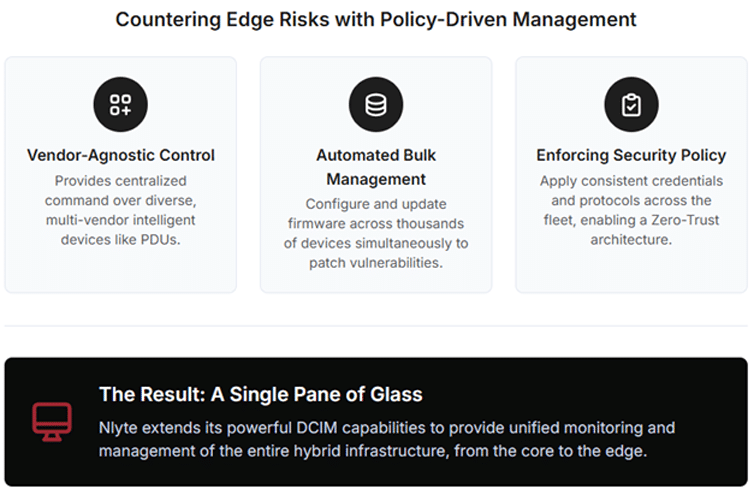Edge Device Security Management with Nlyte
Published on August 22, 2025,
by
Edge Device Security Management with Nlyte
As edge computing continues to reshape the digital infrastructure landscape, organizations face a growing challenge: how to secure and manage thousands of distributed devices across remote, often unmanned environments. These edge deployments, while essential for real-time data processing and low-latency applications, introduce significant operational and security complexities. Within the framework of Integrated Data Center Management (IDCM), edge device security management becomes a critical priority.
Nlyte’s IT Device Security Management solution, also known as Nlyte Device Management—offers a centralized, policy-driven approach to managing and securing edge infrastructure. By extending its powerful DCIM capabilities to the edge, Nlyte provides a unified platform for monitoring, configuring, and enforcing security across a diverse fleet of devices. This centralized command model is essential for maintaining uptime, reducing risk, and ensuring compliance in distributed environments.
The Edge Security Challenge
Edge computing environments are inherently more vulnerable than traditional data centers. With devices deployed in locations like retail closets, cell towers, and factory floors, physical security is often minimal. Additionally, the diversity of hardware and lack of on-site personnel make manual management impractical.
Common security risks at the edge include:
- Physical tampering or theft due to unsecured deployment locations
- Outdated firmware with known vulnerabilities
- Weak or hardcoded credentials on IoT and edge devices
- Unencrypted data transmission across public or private networks
These risks demand a new approach—one that moves beyond traditional perimeter-based security and embraces centralized, automated, and policy-driven management.
Centralized Control Across Diverse Devices
One of the standout features of Nlyte’s solution is its vendor-agnostic control. Edge environments often include a mix of intelligent devices from different manufacturers, such as rack-mounted PDUs, sensors, and network appliances. Managing these devices through separate, vendor-specific tools is inefficient and error-prone.
Nlyte Device Management solves this by providing a single pane of glass for controlling all devices, regardless of vendor. This centralized control simplifies operations, reduces training requirements, and ensures consistent policy enforcement across the entire infrastructure.
In the context of edge device security management, this capability is vital. It allows organizations to apply security protocols uniformly, monitor device health in real time, and respond quickly to emerging threats.
Automated Bulk Management and Firmware Updates

Manual configuration and patching of edge devices is not scalable. With potentially thousands of devices deployed across remote sites, automation is the only viable solution. Nlyte’s platform enables automated bulk management, allowing operators to configure settings and update firmware across large fleets simultaneously.
This automation addresses one of the most pressing security concerns: outdated firmware. Many edge and IoT devices are shipped with vulnerabilities that can be exploited if not patched promptly. Nlyte’s bulk update capabilities dramatically reduce the attack surface by ensuring that all devices are running the latest, most secure software versions.
This not only enhances security but also eliminates countless hours of manual labor, freeing up IT teams to focus on strategic initiatives.
Enforcing Security Policies at Scale
Security at the edge must be consistent, proactive, and aligned with Zero Trust principles. Nlyte Device Management supports policy-driven configuration, enabling organizations to enforce network settings, user credentials, and security protocols across all devices.
This ensures that:
- Access controls are properly configured and maintained
- Encryption standards are uniformly applied
- Authentication mechanisms are robust and up to date
By embedding these policies into the management platform, organizations can maintain a secure operational state across their entire edge infrastructure. This is a cornerstone of edge device security management, especially in environments where manual oversight is impossible.
Supporting Zero Trust Architecture
The shift to edge computing requires a fundamental change in security philosophy. The traditional “trust but verify” model is no longer sufficient. Instead, organizations must adopt a Zero Trust approach—where every access request is verified, every device is authenticated, and no implicit trust is granted.
Nlyte’s platform supports this model by:
- Enabling continuous identity validation
- Supporting micro-segmentation to limit lateral movement
- Enforcing least privilege access across all devices
These capabilities ensure that even if one device is compromised, the impact is contained and mitigated. Within an IDCM framework, this level of security integration is essential for protecting both core and edge infrastructure.
Final Thoughts
As edge computing becomes more widespread, the need for robust, scalable, and intelligent security management grows exponentially. Nlyte’s IT Device Security Management solution offers a powerful answer to this challenge, providing centralized control, automated updates, and policy enforcement across diverse edge environments.
Edge device security management is no longer a luxury, it’s a necessity. By integrating these capabilities into their IDCM strategy, organizations can ensure that their distributed infrastructure remains secure, compliant, and resilient.
Whether you're managing a handful of remote sites or a global network of edge deployments, Nlyte’s platform empowers you to take control, reduce risk, and operate with confidence in the age of distributed computing.

